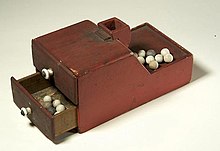
Blackballing is a rejection in a traditional form of secret ballot, where a white ball or ballot constitutes a vote in support and a black ball signifies opposition.[1][2] The system is typically used where an organization's rules provide that one or two objections, rather than an at-least-50% share of votes, are sufficient to defeat a proposition. Since the seventeenth century, these rules have commonly applied to elections to membership of many gentlemen's clubs and similar institutions such as Masonic lodges and fraternities.
A large supply of black and white balls is provided for voters. Each voter audibly casts a single ball into the ballot box under cover of the box, or of a combination of a cloth and the box itself, so that observers can see who votes but not how they are voting. When all voting is complete, the box is opened and the balls displayed: all present can immediately see the result, without any means of knowing which members are objecting.
In America, members of fraternal clubs often voted at their meetings without paper ballots as early as the 17th century. In order to progress, votes had to be unanimous in nature, as a single vote against was enough to apply veto. A blackball box was used instead of paper ballots for this reason.[2]
- ^ "Blackball". Dictionary.com. Archived from the original on 2012-07-12. Retrieved 2012-06-30.
- ^ a b Kovel, Terry. "Ever wonder where the term 'blackballed' comes from?". Wisconsin State Farmer. Retrieved 2023-09-10.
© MMXXIII Rich X Search. We shall prevail. All rights reserved. Rich X Search
